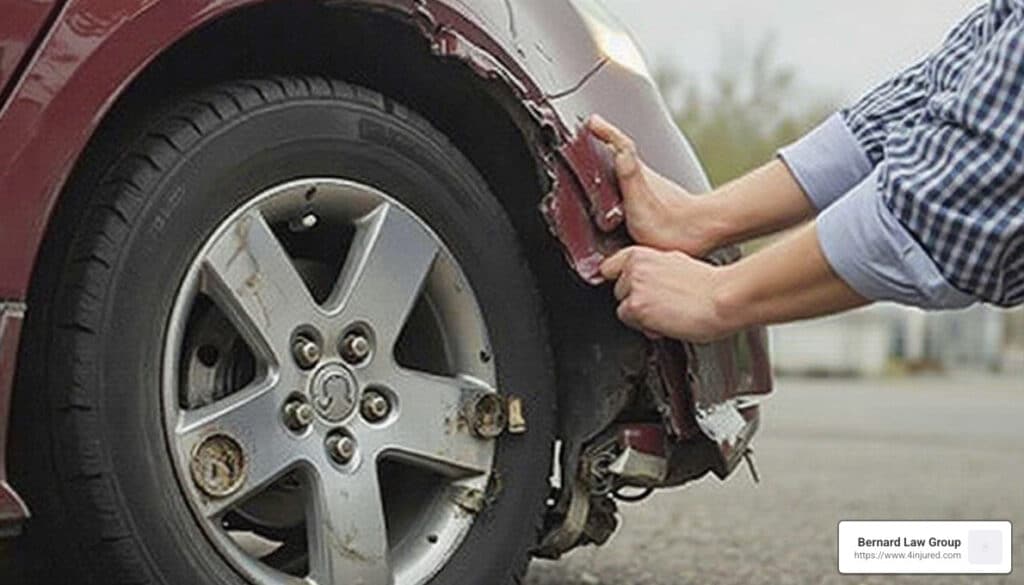Rear-end car accident injuries are unfortunately a common result of collisions on the road. When one vehicle crashes into the back of another, the consequences can be both physically and financially devastating. Some immediate injuries you might experience include:
- Whiplash: The sudden jolt can strain neck muscles.
- Back injuries: Sprains, herniated discs, or worse.
- Head trauma: Including concussions or traumatic brain injuries.
- Facial injuries: Cuts or fractures from impact.
- Spinal cord injuries: Can lead to long-term disability.
These injuries can arise in a matter of seconds, but their effects can last a lifetime. Rear-end collisions make up roughly a third of all traffic accidents, highlighting the importance of knowing your rights and the steps to take after such an ordeal.
While many believe they are just “fender benders,” these incidents can lead to severe physical harm. It’s crucial to seek medical attention right away and consult with a knowledgeable lawyer to steer your legal options. Protecting your well-being and securing rightful compensation is key, especially when dealing with overwhelming medical bills and lost wages.
Stay informed and proactive, ensuring you’re equipped to handle the aftermath of a rear-end collision with confidence.

Common Rear-End Car Accident Injuries
Rear-end collisions are more than just minor inconveniences. They can cause major injuries that affect your daily life. Let’s explore some of the most common rear end car accident injuries you might encounter.
Whiplash
Whiplash is the most frequent injury from rear-end accidents. Imagine your neck being snapped back and forth like a whip. This rapid movement strains your neck muscles and ligaments. Symptoms include neck pain, stiffness, and headaches. Untreated, whiplash can lead to chronic discomfort.
Back Pain
The impact from a rear-end collision can wreak havoc on your back. You might experience anything from mild sprains to severe herniated discs. These injuries can cause ongoing pain and limit your mobility. In some cases, extensive medical treatment and rehabilitation are necessary to regain full function.
Traumatic Brain Injury (TBI)
Even with airbags, your head might still hit the steering wheel or headrest, leading to a TBI. Symptoms like memory loss, confusion, and headaches may not appear immediately, making it crucial to seek medical attention after any head impact.
Facial Injuries
Facial injuries can result from shattered glass or hitting the airbag. Cuts, bruises, or even broken bones are common. These injuries might require cosmetic surgery and can leave lasting scars, affecting both physical appearance and emotional well-being.
Spinal Cord Injuries
Perhaps the most severe, spinal cord injuries can lead to partial or complete paralysis. The force of the collision can damage or sever the spinal cord, altering your life forever. Immediate medical care and long-term rehabilitation are essential to manage these injuries.
Each of these injuries can significantly impact your life. Understanding them helps you better steer the recovery process and seek appropriate legal compensation.
Causes of Rear-End Collisions
Rear-end collisions are surprisingly common and can happen in the blink of an eye. Understanding the causes can help you avoid these accidents and the rear end car accident injuries that often follow. Let’s explore some of the primary reasons behind these crashes.
Distracted Driving
Distracted driving is one of the leading causes of rear-end collisions. Imagine a driver glancing at their phone, fiddling with the radio, or even chatting with passengers. These distractions take their eyes off the road, and before they know it, they’ve hit the car in front of them.

Speeding
Speeding drivers have less time to react to sudden stops. If you’re zooming down the road and the car ahead brakes suddenly, you might not have enough distance to stop safely. At high speeds, the impact is more severe, leading to more serious injuries.
Tailgating
Tailgating is when a driver follows another vehicle too closely. This aggressive behavior leaves little room for error. If the car in front stops unexpectedly, a tailgating driver won’t have enough space to brake in time, leading to a collision.
Vehicle Malfunction
Sometimes, rear-end collisions aren’t the driver’s fault. A vehicle malfunction, like brake failure, can prevent a driver from stopping in time. Regular car maintenance is crucial to avoid these unexpected mechanical failures.
Fatigued Driving
Driving while tired is similar to driving under the influence. Fatigue slows reaction times and impairs judgment. A drowsy driver might not notice traffic slowing down or a red light, increasing the risk of a rear-end crash.
By understanding these causes, you can take steps to prevent rear-end collisions, protecting yourself and others on the road.
Legal Rights and Compensation
Facing rear end car accident injuries can be overwhelming, but understanding your legal rights and potential compensation can provide some relief. Let’s break down what you might be entitled to if you find yourself in this unfortunate situation.
Economic Damages
Economic damages cover the tangible financial losses you incur due to the accident. These include:
-
Medical Expenses: This is often the most immediate concern. You can claim compensation for all medical costs related to your injury, such as hospital stays, surgeries, physical therapy, and even future medical care if required.
-
Lost Wages: If your injuries prevent you from working, you can recover the income you’ve lost. This includes not just your regular salary but also any overtime or bonuses you might have missed out on.
Non-Economic Damages
While economic damages are straightforward, non-economic damages cover more subjective losses. These include:
-
Pain and Suffering: This accounts for the physical pain and emotional distress you experience due to the accident. Calculating this can be complex, but expert testimonies and personal accounts help build your case.
-
Loss of Enjoyment of Life: If your injuries prevent you from enjoying activities you once loved, you could be entitled to compensation for this loss.
Punitive Damages
In some cases, you might also be eligible for punitive damages. These are awarded when the at-fault party’s behavior is especially reckless or negligent. While not common, they serve as a punishment and deterrent.
Securing Your Compensation
Navigating the legal landscape after a rear-end collision can be tricky. An experienced attorney will help you gather evidence, negotiate with insurance companies, and ensure you receive the full compensation you deserve.
By knowing your rights and the types of compensation available, you can focus on healing and getting back to your life.
Preventing Rear-End Collisions
Rear-end collisions are common, but the good news is they are often preventable with a few simple practices. Let’s explore how you can reduce the risk of these accidents by maintaining a safe following distance, avoiding distractions, and obeying traffic laws.
Safe Following Distance
One of the key ways to prevent rear-end collisions is by keeping a safe following distance. This means staying far enough behind the vehicle in front of you to allow for sudden stops. A simple rule is the “three-second rule”: pick a fixed point ahead, and when the vehicle in front passes it, count three seconds before you pass the same point. In poor weather conditions, double this distance to six seconds. This buffer gives you ample time to react if the driver ahead brakes suddenly.
Avoiding Distractions
Distractions are a leading cause of rear-end collisions. Whether it’s texting, adjusting the radio, or even chatting with passengers, taking your focus off the road for even a second can lead to an accident. Avoiding distractions means keeping your eyes on the road, hands on the wheel, and mind focused on driving. Consider setting your phone to “Do Not Disturb” mode while driving to eliminate the temptation to check messages.
Obeying Traffic Laws
Traffic laws are designed to keep everyone safe. Obeying speed limits and traffic signals can significantly reduce the risk of a rear-end collision. Speeding reduces your ability to stop in time, especially in unexpected situations. Also, always use your turn signals to communicate your intentions to other drivers, reducing the likelihood of sudden stops or surprises.

By practicing these safe driving habits, you can help keep yourself and others safe on the road. Preventing accidents is always better than dealing with the consequences.
Frequently Asked Questions about Rear End Car Accident Injuries
What injury is most common with rear-end collisions?
When it comes to rear end car accident injuries, whiplash is the most frequently reported. This happens when the neck snaps forward and backward rapidly, much like the cracking of a whip. According to the Mayo Clinic, this sudden movement can stretch your neck’s tendons and ligaments, causing pain and stiffness.
Broken bones, although less common than whiplash, also occur in rear-end collisions. The impact can cause fractures, especially to the ribs and pelvis, due to seatbelt pressure or bracing for impact.
How can I prove emotional distress after a car accident?
Emotional distress is a serious consequence of car accidents. It can manifest as anxiety, depression, or even PTSD. To prove this kind of psychological harm, you need documentation from mental health professionals. They can provide assessments that detail how the accident has affected your mental well-being.
Keeping a journal of your feelings and any changes in behavior can also support your claim. Documenting episodes of anxiety or PTSD, such as nightmares or panic attacks, helps create a clear picture of your emotional distress.
What should I do immediately after a rear-end collision?
After a rear-end collision, your first priority is to check for injuries. Make sure you and your passengers are okay. If anyone is hurt, call 911 immediately to get medical help.
Next, document the scene. Take photos of the vehicles, any visible damage, and the surrounding area. This information is crucial for insurance claims and any potential legal action.
Finally, exchange contact and insurance details with the other driver, and collect contact information from any witnesses. This will help if there are any disputes about what happened.
By taking these steps, you can protect your health and your rights after a rear-end collision.
Conclusion
When you face the aftermath of a rear-end car accident, navigating the legal landscape can feel overwhelming. That’s where we come in. At Bernard Law Group, we specialize in helping accident victims secure the compensation they deserve. Our free case reviews mean you can explore your legal options without any initial costs.
We have a proven track record of securing large settlements for our clients. Our team understands the complexities of rear end car accident injuries, be it whiplash, broken bones, or emotional distress. We work tirelessly to ensure you receive compensation for medical expenses, lost wages, and more.
Our commitment extends beyond just winning cases. We are deeply involved in the community and believe in standing by our clients every step of the way. With offices in Seattle, Bellevue, Bellingham, Everett, Federal Way, and Kent, we are conveniently located to serve you.
If you’ve been involved in a rear-end collision and need expert legal guidance, don’t hesitate to reach out. Let us help you steer this bump in the road and secure the settlement you deserve.
Contact us for a free consultation and take the first step towards recovery.




